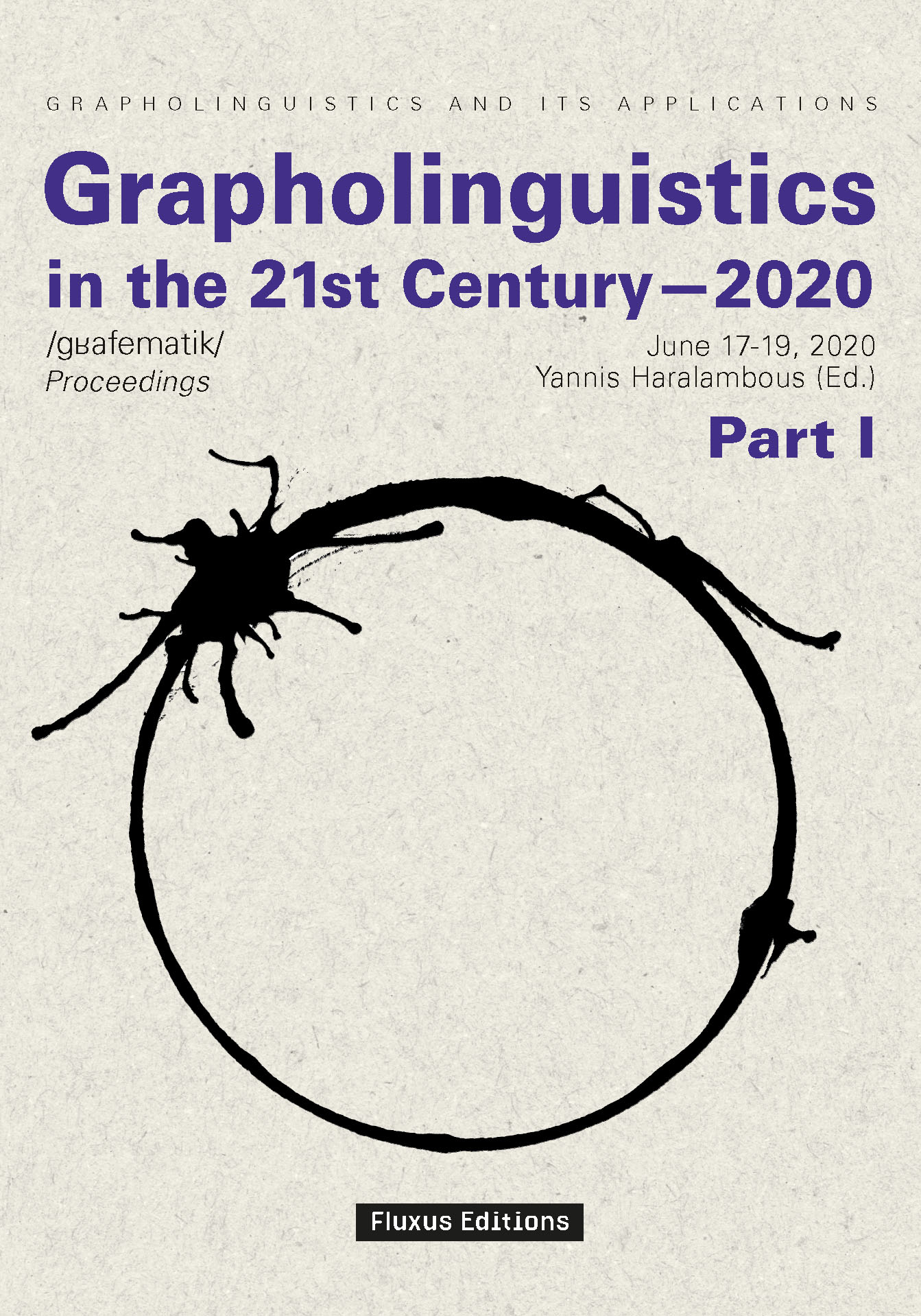
 ISSN: 2534-5192 (electronic) – 2681-8566 (print)
ISSN: 2534-5192 (electronic) – 2681-8566 (print)
 ISSN: 2534-5192 (electronic) – 2681-8566 (print)
ISSN: 2534-5192 (electronic) – 2681-8566 (print)| ◀ M. Pierson | ▲ Proceedings | C. Dürscheid ▶ |
 ISBN: 978-2-9570549-6-1 e-ISBN: 978-2-9570549-8-5  | Sociocultural Motivation for Spelling Variation in Modern Hebrew Yishai Neuman  Abstract. Ideological tendencies and cultural preferences may at times constitute powerful factors in motivating spelling variation in variable social environments. Such tendencies and preferences may stem from religious taboo or represent modern political or seemingly-historic nuances. Since Sebba’s (2007) account Spelling and Society: The culture and politics of orthography around the world leaves Hebrew outside of scope, the following brief account offers an overview of categories in which variable spelling conveys ideological perceptions and sociocultural stances. DOI: https://doi.org/10.36824/2020-graf-neum
@BOOK{andersen1986a,
AUTHOR = {Andersen, F.I. and Forbes, D.A.},
TITLE = {Spelling in the Hebrew Bible},
PUBLISHER = {Biblical Institute Press},
ADDRESS = {Rome},
YEAR = {1986},
}
@INPROCEEDINGS{aronoff1994a,
AUTHOR = {Aronoff, M.},
EDITOR = {Watt, I.},
TITLE = {Spelling as Culture},
BOOKTITLE = {Writing Systems and Cognition: Perspectives from Psychology, Physiology, Linguistics, and Semiotics},
PUBLISHER = {Kluwer Academic Publishing},
ADDRESS = {Dordrecht, Boston, London},
YEAR = {1994},
PAGES = {67--86},
}
@ARTICLE{ben-shahar1995a,
AUTHOR = {Ben-Shahar, R.},
TITLE = {The Phonetic Representation of Spoken Language in Modern Hebrew Literature},
JOURNAL = {TTR: Traduction, terminologie},
YEAR = {1995},
VOLUME = {8},
PAGES = {245--273},
}
@ARTICLE{bolinger1946a,
AUTHOR = {Bolinger, D.L.},
TITLE = {Visual Morphemes},
JOURNAL = {Language},
YEAR = {1946},
VOLUME = {22},
PAGES = {333--340},
}
@BOOK{carney1994a,
AUTHOR = {Carney, E.},
TITLE = {A Survey of English Spelling},
PUBLISHER = {Routledge},
ADDRESS = {London, New York},
YEAR = {1994},
}
@ARTICLE{cohen-gross-a,
AUTHOR = {Cohen-Gross, D. and Ilani, N.},
AUTHOR_ORIGINAL = {כהן-גרוס, דליה and ונוגה אילני},
AUTHOR_ORIGINAL+AN = {1=he-Hebr;2=he-Hebr},
TITLE = {{\texthebrew{?מילוי הכתיב בספרים בישראל – מכוּון או מזדמן}} [Non-vocalized Orthography in Israeli books – planned or unplanned?]},
JOURNAL = {{\texthebrew{חלקת לשון}} [Smooth Tongue]},
YEAR = {2006--2007},
VOLUME = {37--38},
PAGES = {33--47},
}
@BOOK{cross1952a,
AUTHOR = {Cross, F.M. and Noel, F.D.},
TITLE = {Early Hebrew Orthography: A Study of the Epigraphic Evidence},
PUBLISHER = {American Oriental Society},
ADDRESS = {New Haven},
YEAR = {1952},
}
@ARTICLE{fellman1974a,
AUTHOR = {Fellman, J.},
TITLE = {The Academy of the Hebrew Language: Its History, Structure and Function},
JOURNAL = {Linguistics},
YEAR = {1974},
VOLUME = {120},
PAGES = {95--103},
}
@INPROCEEDINGS{hary1996a,
AUTHOR = {Hary, B.},
EDITOR = {Daniels, Peter T. and Bright, William},
TITLE = {Adaptations of Hebrew Script},
BOOKTITLE = {The World's Writing Systems},
PUBLISHER = {Oxford University Press},
ADDRESS = {Oxford},
YEAR = {1996},
PAGES = {727--742},
}
@BOOK{kosover1966a,
AUTHOR = {Kosover, M.},
TITLE = {Arabic Elements in Palestinian Yiddish: The Old Ashkenazic Jewish Community in Palestine, Its History and Its Language},
PUBLISHER = {Rubin Mass},
ADDRESS = {Jerusalem},
YEAR = {1966},
}
@PHDTHESIS{landman2014a,
AUTHOR = {Landman, Sh.},
AUTHOR_ORIGINAL = {לנדמן, שלומית},
AUTHOR_ORIGINAL+AN = {1=he-Hebr},
TITLE = {{\texthebrew{מהדסה להדס, מאליעזר לאלעזר – מאפיינים לשוניים ותרבותיים בשמות פרטיים של המגזר היהודי במדינת ישראל}} [From Hadassah to Hadas, from Eliezer to Elazar, Linguistic and Cultural Characteristics of Given Names of the Jewish Sector in the State of Israel]},
SCHOOL = {{\texthebrew{רמת-גן: אוניברסיטת בר-אילן}} [Bar-Ilan University, Ramat-Gan]},
YEAR = {2014},
}
@BOOK{masson1986a,
AUTHOR = {Masson, M.},
TITLE = {Langue et idéologie: Les mots étrangers en hébreu moderne},
PUBLISHER = {Éditions du CNRS},
ADDRESS = {Paris},
YEAR = {1986},
}
@ARTICLE{moreshet1968a,
AUTHOR = {Moreshet, M.},
AUTHOR_ORIGINAL = {מורשת, מנחם},
AUTHOR_ORIGINAL+AN = {1=he-Hebr},
TITLE = {{\texthebrew{הערות לבעית הכתיב המלא}} [Comments on the Problem of Plene Spelling in Hebrew]},
JOURNAL = {{\texthebrew{לשוננו לעם}} [Our Language to the People]},
YEAR = {1968},
VOLUME = {19},
PAGES = {227--241},
}
@ARTICLE{moreshet1969a,
AUTHOR = {Moreshet, M.},
AUTHOR_ORIGINAL = {מורשת, מנחם},
AUTHOR_ORIGINAL+AN = {1=he-Hebr},
TITLE = {{\texthebrew{כתיב “מלא” המעיד על שיבוש לשון}} [Plene Spelling in Hebrew Indicating Language Errors]},
JOURNAL = {{\texthebrew{לשוננו לעם}} [Our Language to the People]},
YEAR = {1969},
VOLUME = {20},
PAGES = {54--84},
}
@PHDTHESIS{neuman2009a,
AUTHOR = {Neuman, Y.},
TITLE = {L'influence de l'écriture sur la langue},
SCHOOL = {Université de la Sorbonne Nouvelle, Paris},
YEAR = {2009},
}
@INPROCEEDINGS{neuman2013a,
AUTHOR = {Neuman, Y.},
TITLE = {Diachronic, Ideological and Linguistic Motivations in Spelling Foreignness (Xenographemics) in Yiddish and Hebrew},
BOOKTITLE = {The 46th Annual Meeting of the Societas Linguistica Europaea---special session on Conflicting Orthographies},
ADDRESS = {Split, Croatia},
YEAR = {2013},
}
@INPROCEEDINGS{neuman2015a,
AUTHOR = {Neuman, Y.},
TITLE = {The popular-learned opposition in Modern Hebrew lexical Arabisms},
BOOKTITLE = {The North American Conference on Afroasiatic Linguistics (NACAL)},
PUBLISHER = {Georgetown University, Washington DC},
YEAR = {2015},
}
@UNPUBLISHED{or2004a,
AUTHOR = {Or, Y.},
AUTHOR_ORIGINAL = {אור, יאיר},
AUTHOR_ORIGINAL+AN = {1=he-Hebr},
TITLE = {{\texthebrew{למה המלה <מלה> תהיה מעכשיו <מילה>?}} [Why
Yishai Neuman (2020), “Sociocultural Motivation for Spelling Variation in Modern Hebrew,” in Proceedings of Grapholinguistics in the 21st Century, 2020 (Yannis Haralambous, Ed.), Grapholinguistics and Its Applications, Vol. 4, Brest: Fluxus Editions, 489–499.
@INPROCEEDINGS{gla4-neum,
AUTHOR = {Yishai Neuman},
EDITOR = {Haralambous, Yannis},
TITLE = {{Sociocultural Motivation for Spelling Variation in Modern Hebrew}},
BOOKTITLE = {{Proceedings of Grapholinguistics in the 21st Century, 2020}},
SERIES = {{Grapholinguistics and Its Applications}},
VOLUME = {4},
PUBLISHER = {Fluxus Editions},
ADDRESS = {Brest},
YEAR = {2020},
PAGES = {489--499},
DOI = {https://doi.org/10.36824/2020-graf-neum},
}
|